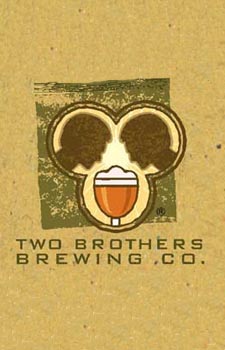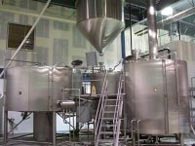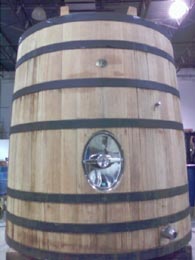Then
How does one make the leap from homebrewer to craft brewer? It’s a great question. When we opened in 1996 micros were just starting. Everybody and his brother were trying to contract something and put it out there to make their million dollars. People were buying and installing breweries that had no idea how to brew and there was just a bunch of crap on the market. But Jason and I had a different insight because we both lived in Europe. We were able to travel a lot and see the cultural impact of beer, you know. It wasn’t the yellow fizzy stuff that dad drank during football games. It was stuff that brought people together and that they enjoyed with meals. It was just way different than what I’d come to expect being a teenager in America where you thought you were really drinking something special if you had Moosehead. We were just enamored with that lifestyle and that kind of vision. Then when Jason graduated from college he moved to Denver and got a job with Tabernash when it was still around. I helped out there some, so we had some hands on experience. It maybe wasn’t as daunting as it would be without any time inside a brew house. When we were getting ready to open Jason went to the Siebel Institute and I was studying for the bar exam and writing the business plan. Other than the brew house we had all used equipment, some of it donated, so it was a reasonable expense for us to start up. Plus we were both young enough at that point that we figured if we try this and we fail at least we can say we tried, and we will still have time to rebound financially from it. So we took that leap of faith and just had the tenacity I guess to stick with it and make it work.
My brother and I shared an office for ten years – eleven years actually. You put your sibling relationship to the test in that, I can tell you. In the beginning we had a twenty hectoliter (17-barrel) brewing system, two bulk milk tanks that our grandfather gave us, and then we bought two cream tanks. The bulk milk tanks had tops that lift off so it was like open fermentation essentially. The cream tanks were enclosed and we used those as bright tanks. And that was it. We had four tanks along with 200 half-barrels. We filled by hand out of the bottom of the bright tank. It was quite a bit different. But in thirteen years you would hope it would be different I guess. It looks impressive now, but it’s a lot of blood sweat and tears and a lot of lean years where Jason and I literally put everything back into the business.
And Now
We moved into the new brewery just two years ago now. We changed things a lot when we did. The new brew house is a fifty-barrel. When we moved we added a hundred-barrel and a fifty-barrel tank. We added some more hundred-and-fifty-barrel tanks about a year ago. Tomorrow we’ve got another four hundred and fifty barrels of tank capacity coming. It’s going crazy, which is a good thing I guess. We’ve got a couple of old thirty-barrel tanks left. I remember when we got those we thought they were huge. Now we just do little play stuff in them. We’ve got a brett beer in one of them that’s just aging. Most of our big production beers are in the hundreds or hundred-fifties. Honestly I don’t even know what our capacity is any more. With the new tanks coming it’s got to be up around twenty thousand barrels. Maybe even a little more than that.
Windy City Distribution
We didn’t have this grand master scheme in starting Windy City Distribution. We just couldn’t find anyone in Chicago that was interested in distributing our beer. The first year that we were in business we made a hundred and sixty-three barrels of beer. So, we’re talking about three hundred kegs. It was all draft. No bottles. And no distributor had any interest at all. So we were stuck either self-distributing or just closing shop. But then as we went to the Great American Beer Festival and the Great Taste of the Midwest and some of the other brewer conferences, we met other brewers in the Midwest that were having a lot of the same problems. People were like, “Well, you’ve got a license why don’t you distribute my beer?” We thought about it and it made sense. It’s kind of silly not to. We’re providing a service to our industry. We’re big believers in the rising tide raises all ships. And it made sense from a financial standpoint too. We’re already going to liquor stores to drop our boxes. If we could drop twice as many boxes it would cost us half as much to go there. So we bought a little van and hired a salesperson. That was ten years ago. And we were just able to pick up more and more brands as we met more and more people and people liked what we were doing. Today it’s a big business. Windy City just made the INC Five Thousand List of the fastest growing companies in the US for the third year in a row. All of our sales people are Certified Cicerones. So it’s doing well. I love it. It’s great to be able to provide Chicago with such great beers.
Philosophy of Brewing
I think our brewing philosophy is two-fold. With our everyday beers I like the word balance. We really try hard to make sure that all of our beers are balanced. Because it’s really easy to make a barleywine by just dumping a load of barley into a beer or adding invert sugar or whatever you’re doing to bump your gravity up. And I think it’s really easy to make a triple IPA where you’re just adding tons and tons of cascade hops. No offense to those people who are doing that or the people who are drinking it, but if you have defects in a beer like that they’re easily masked. And I have a hard time drinking beers like that. If you look at our imperial stout, it’s on the very low end of an imperial stout. It’s only eight or eight-and-a-half percent. You get imperial stouts now that are twelve percent. And some of those beers, they just get so cloyingly sweet because you can’t fully attenuate them. I have a hard time drinking them. It’s the same with super bitter beers. I like bitter beers. I love hops, but at some point I lose the pleasure in that drink once it gets so hoppy. So we really try to make sure that our beers are well balanced. And then I guess the second tier of that is sort if the inventiveness of being able to craft what we want. A big part of the attraction to brewing for my brother and I is that it’s very technical. There is a lot of science behind it, but it’s really meshed with creativity and that sort of inventive component that we both really love. In our artisan series you’re going to see a lot more of that inventiveness, creativeness, and unique ingredients. You already find that in something like Cane & Ebel, which is a year-round beer for us that is brewed with Thai palm sugar. But we still strive to insure that it’s well balanced and multi-dimensional.
The Artisan Series
When we got our new bottling filler it was adjustable so we could do different size bottles. We decided that was a great opportunity to get specialty products onto the market in a bottled form. The problem with putting it out in twelve ounce bottles it that either it’s a single twelve ounce, which Avery and Dogfish Head can do, but for most people it’s not very acceptable. Or you have to go to the expense of printing sixpacks which is beaucoup money. So a twenty-two ounce bottle allows us to put out a product that we can do a real limited run label printing on and there’s no other packaging for it. But we’ve always wanted to make specialty beers and one-off beers and experiment, because that’s a huge part of the fun for us. Otherwise we’re in the brewery every day, I mean the brewers when I say “we”, trying to be as consistent as possible. That means lots of repetition trying to make things the same every time. It gets boring. But with the artisan series we can sit down once every eight or ten weeks and say, “Let’s do something fun guys. What do you think we should make this time? Let’s do a Baltic porter with coffee. Great.” Then we think about a recipe. We start playing with some coffee. And we’re able to play with what works best as far as infusing that coffee character. And then Randy (Mosher) makes a label and off we go. It gives everybody a chance to kind of sit back, get the creative juices going, and do something fun. So that’s really the basis behind it, it lets us do off the wall stuff. We never want to put an IPA in twenty-two ounce bottles. That’s no fun. But we have done braggots. We did a cyser and a coffee porter. We did a sour beer. And all those are released in that format.
Where do we go from here?
The question is where do we expand from here? We have Windy City Distribution next door. We’ve got six new tanks coming tomorrow. I don’t even know exactly where we’re going to put them. With Windy City pushing that way and Two Brothers pushing this way we’re going to have to come up with another solution here in the next year or so. When we bought this building two years ago we thought we were set for life. I remember bringing the sales staff from Windy City over. We walked in and this was nothing. There was a tennis ball over there and somebody picked up the tennis ball and threw it as hard as they could to try and hit the back wall. We thought, “This place is huge. We’re never going to fill this thing up.” Two years later we’re putting our second batch of palate racks in and then we’re done.
In five years I’d like us to get up to about thirty thousand barrels of production. Right now we package about half of our beers in kegs. We still do a lot of draft beer which we really enjoy. I think the draft is such an integral part of marketing, at least for us with no marketing money. We do beer dinners several times a week. It’s a great way to market our beers and to reach out and connect with people. To be able to touch people like that is great. And I think draft beer really does that. So I’d love to see us stay very heavy on draft, get to thirty-thousand barrels, and then just kind of stop there. We don’t want to be Goose Island or Summit that’s at a hundred-thousand barrels a year. At some point the business starts to run you instead of the other way around. Thirty-thousand barrels, that’s a nice comfort zone. It’s a point where you can earn a living and you’re big enough to get scales of economy. I’d like to see us become much more famous for some of the sour beers that we’re taking very seriously now. There aren’t many breweries that are doing it in the US, but the ones that are, are doing a great job. If you look at Tomme Arthur and Rob Tod, I mean their beers are off the hook. I’d love to get to the point where we can make sour beers that are on par with theirs and I don’t see any reason why we can’t. |





